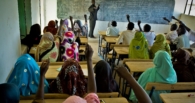Aid for Education after 2015
Mokoro Seminar Report
Stephanie Allan
15 January 2014
/
- 0 Comments
In the face of discernible fatigue around the Post-2015 Agenda, Mokoro’s seminar brought a fresh perspective to the question of what’s next after the MDGs, focusing specifically on the education sector, and bringing to bear emerging thinking on inequality, a preview of the latest report on global education progress, and new research into how partners can engage in education sector policy to facilitate better outcomes.
The panel brought together some of the leading voices on education, including Kevin Watkins, Director of the Overseas Development Institute; Pauline Rose, Director of the annual Education for All Global Monitoring Report; Alta Fölscher, Principal Consultant at Mokoro; and Christopher Colclough, Emeritus Professor of Education and Development at Cambridge University.
Discussions were framed by an introductory presentation on global education progress and financing from Pauline Rose, with a preview of the 2013/14 Education For All Global Monitoring Report (EFA-GMR), an annual publication which tracks progress towards 6 EFA goals. The report card is pretty damning – none of the EFA goals will be met by 2015, due in large part to insufficient financing (the GMR calculates an annual finance gap of $26 billion per year in what is needed to provide universal basic education alone). The pledge made by development partners in 2000 that efforts by countries with a serious commitment to achieving education for all would not be thwarted by lack of resources appears to have gone largely ignored.
Even though domestic resources are the main source of financing, the poorest countries do and will continue to require aid to make sure all children are in school and learning. However, aid to basic education fell by 7% between 2010 and 2011, its first decrease since 2002. This is considerably more than the 3% reduction in total aid over the period, suggesting that at a time when aid is becoming increasingly politicised to serve national interests, basic education is seen as a soft target for cuts. Low-income countries have been particularly affected, with 19 LICs experiencing a reduction in education funding. The GMR is calling for the Post-2015 Goals to include financing targets that require countries to allocate at least 6% of GNP and at least 20% of their budget to education. To complement this, financing targets must also apply to aid donors so that all funders are held to account for their promises.
The lack of progress in global education does not mean we should disregard the role of international goals such as the MDGs and EFA in their totality. Kevin Watkins argued that the goals have helped to put education on the map, if not the forefront of donor and partner Government policy and funding decisions. They have provided a clear target for donors to mobilise around, and a commitment for which citizens can hold their governments to account. He sees addressing inequality as the key for realising further progress in education outcomes. Whilst the number of children out of school dropped significantly in the first 5 years after 2000, almost no progress has been registered since 2006, when we began to run against the buffers of the most difficult to reach. The remaining out-of-school population includes children engaged in labour markets, those forced into early marriage, indigenous minorities, children with disabilities, those in post-conflict countries, and girls in rural sub-Saharan Africa. Traditional approaches of building a school or providing more classroom inputs won’t get these children into school.
This rising disparity in opportunity is not unique to education; similar patterns are playing out in child health and other hard-to-crack dimensions of poverty. In view of this, Kevin called for the next set of goals to be framed around reducing disparities: for example, targeting reductions in the gap between the richest and poorest, best districts and the worst, the high achieving ethnic groups and the least, etc. The report of the High Level Panel on the Post-2015 Development Agenda, which calls for five large-scale transformative shifts, one of which is “Leave No One Behind” (inequality in its depoliticised guise), is pointing in this general direction. However, it was stressed that ensuring accountability for the goals will require a departure from the previous 15-year time horizon, which bears little relation to the time horizons of national political cycles and budget processes. Instead, Kevin advocates a stepping stone approach where absolute goals are broken down into shorter interim targets for which voters can hold their leaders to account.
Given continued pressure on aid budgets, there is bound to be a focus on how development partners can leverage change to partner governments’ policy and funding. Emerging findings from an on-going evaluation of UNICEF’s upstream work in basic education and gender equality provide some insights into how donors can engage in education sector policy to facilitate better education outcomes. Alta Fölscher discussed a number of critical factors which enable donors to maximise their policy influence. She stressed the importance of maximising alignment with existing national priorities, as the introduction of new policy objectives is rarely successful, particularly in attracting national funding. Equally important is ensuring country offices have the required capacity for policy advocacy; in each case this is a country-specific mix of leadership skills, technical skills (both sectoral and financial, to engage on budget allocation decisions), country knowledge, and established relationships. Additionally, donor institutions need to ensure their institutional arrangements are decentralised enough to allow country offices to respond to unfolding situations at the country level.
The confidence and optimism that ushered in the millennium is a far cry from the cuts and the value-for-money ethic that characterise 2014, and there is little reason to expect a level of ambition to match the MDGs in their post-2015 successor. However, as the case of education demonstrates, the key may well lie in designing goals that are relevant to country-level needs and priorities, which include commensurate financing commitments from donors and partner Governments, backed by institutional flexibility, and for which institutions can be held accountable by their constituents.
You must be logged in to post a comment.



